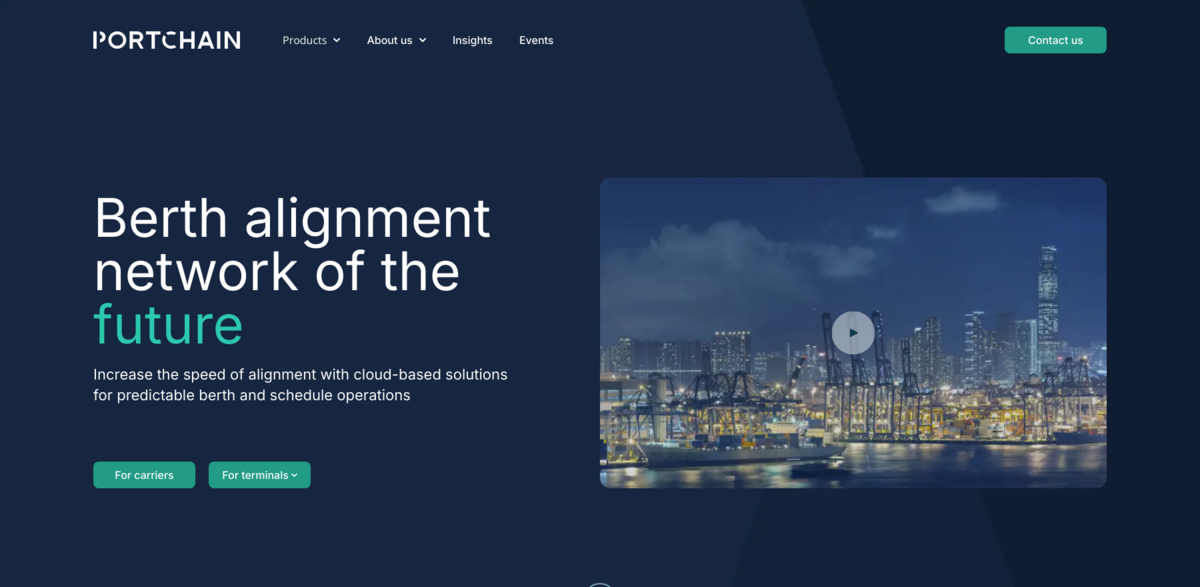What is Portchain?
Portchain is a cutting-edge platform designed to streamline berth alignment processes through what they call a digital handshake. It’s all about making berth scheduling smarter and more efficient by replacing the old-school methods—think spreadsheets, endless emails, and phone calls—with dedicated, fit-for-purpose digital tools. Whether you’re a terminal or a shipping line, Portchain Connect and Portchain Quay offer tailored solutions to optimize operations, improve collaboration, and bring transparency to the complex world of berth planning.
Main Benefits of Using Portchain
Portchain’s solutions bring a whole new level of efficiency and reliability to berth planning. Here are some key facts and figures that highlight its impact:
- Since its launch in 2022, the Portchain Network has saved 800,000 metric tonnes of CO2 emissions.
- Just-In-Time (JIT) arrivals supported by Portchain can reduce fuel consumption and CO2 emissions by 5.9% when aligned 24 hours before arrival, and up to 14% when aligned before leaving the previous port.
- Replaces spreadsheets and emails with modern, cloud-based tools that keep berth information always up to date.
- Improves collaboration by connecting directly to carrier and terminal systems.
- Stabilizes berth windows and helps teams plan more intelligently, resulting in greater alignment, efficiency, and trust.
Digitizing Berth Operations
Gone are the days of juggling spreadsheets and chasing down emails. Portchain digitizes berth planning by connecting operations directly to source data through multiple integration options. This means terminals and shipping lines always have the latest info at their fingertips. Plus, configurable views let users share data with control—knowing exactly what’s shared and with whom. It’s about running operations smarter, faster, and with less friction.
How Portchain Supports Just-In-Time Port Calls
Just-In-Time (JIT) port calls are a game changer for sustainability and efficiency. By enabling vessels to optimize their speed during voyages, JIT arrivals eliminate waiting times at ports. Portchain Connect facilitates this by enabling precise, timely data exchange between carriers and terminals. This alignment reduces idle time, optimizes berth allocation, and ultimately lowers fuel consumption and CO2 emissions. The IMO study backs this up, showing significant environmental benefits when carriers and ports align their schedules well in advance.
Portchain’s Tools: Connect and Quay
Portchain offers two main tools tailored to different needs. Portchain Connect is all about berth alignment for terminals and carriers, speeding up schedule coordination through digital handshakes on Estimated Times of Arrival (ETA) and Departure (ETD). On the other hand, Portchain Quay focuses on terminals and ports, offering scenario-enabled berth planning that optimizes quayside operations. This tool boosts transparency, stakeholder alignment, and cost efficiency—helping ports run smoother and smarter.
Portchain’s Impact on Sustainable Development Goals (SDGs)
- SDG 9: Industry, Innovation, and Infrastructure – through digitalizing berth planning and fostering innovation in shipping operations.
- SDG 13: Climate Action – by reducing CO2 emissions via Just-In-Time arrivals and optimized berth allocation.
- SDG 17: Partnerships for the Goals – connecting terminals, shipping lines, and ports to collaborate and share real-time data.
The Future of Shipping with Portchain
The global container shipping industry faces huge challenges—congestion, disruptions, constant delays. Traditional tools like proforma plans just don’t cut it anymore. Portchain envisions a future where shipping lines and terminals achieve predictable, reliable operations through increased collaboration and data sharing. By bringing together terminals, mainliners, feeders, and ports—including several top-10 shipping lines—the Portchain Network is driving digitalization and efficiency across the board. It’s not just about technology; it’s about building trust, confidence, and a more sustainable shipping ecosystem.





















